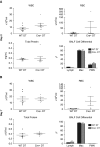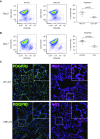Ablation of Pericyte-Like Cells in Lungs by Oropharyngeal Aspiration of Diphtheria Toxin
- PMID: 27779900
- PMCID: PMC5359647
- DOI: 10.1165/rcmb.2016-0083MA
Ablation of Pericyte-Like Cells in Lungs by Oropharyngeal Aspiration of Diphtheria Toxin
Abstract
We demonstrated previously that FoxD1-derived cells in the lung are enriched in pericyte-like cells in mouse lung. These cells express the common pericyte markers and are located adjacent to endothelial cells. In this study, we demonstrate the feasibility of administering diphtheria toxin (DT) by oropharyngeal aspiration as an approach to ablating FoxD1-derived cells. We crossed mice expressing Cre-recombinase under the FoxD1 promoter to Rosa26-loxP-STOP-loxP-iDTR mice and generated a bitransgenic line (FoxD1-Cre;Rs26-iDTR) in which FoxD1-derived cells heritably express simian or human diphtheria toxin receptor and are sensitive to DT. We delivered low-dose (0.5 ng/g) and high-dose (1ng/g × 2) to FoxD1-Cre;Rs26-iDTR mice and littermate control mice by oropharyngeal aspiration and evaluated ablation by flow cytometry and immunohistochemistry. FoxD1-Cre mice showed a 40-50% reduction in PDGFRβ+ cells by flow cytometry at Days 2 and 7 after DT administration, with a return of PDGFRβ+ cells at Day 28. Confocal microscopy revealed an observable reduction in pericyte markers. Bronchoalveolar lavage fluid analysis revealed no significant differences in total protein, bronchoalveolar lavage fluid red blood cell, or white blood cell counts at low dose. However, at high-dose DT, there was a proinflammatory effect in the control mice and increased mortality associated with systemic toxicity in Cre+ mice. Low-dose DT reduced lung PDGFRβ+ stromal cells in the FoxD1-Cre;iDTR transgenic model without a differential effect on lung inflammation in DT-sensitive and DT-insensitive animals. Low-dose DT is a viable method for transient lineage-specific stromal cell ablation in the lung that minimizes systemic toxicity.
Keywords: FoxD1; ablation; diphtheria toxin; pericytes; platelet-derived growth factor receptor β.
Figures




Similar articles
-
Lung pericyte-like cells are functional interstitial immune sentinel cells.Am J Physiol Lung Cell Mol Physiol. 2017 Apr 1;312(4):L556-L567. doi: 10.1152/ajplung.00349.2016. Epub 2017 Feb 10. Am J Physiol Lung Cell Mol Physiol. 2017. PMID: 28188224 Free PMC article.
-
Effect of lung pericyte-like cell ablation on the bleomycin model of injury and repair.Am J Physiol Lung Cell Mol Physiol. 2022 Apr 1;322(4):L607-L616. doi: 10.1152/ajplung.00392.2021. Epub 2022 Feb 23. Am J Physiol Lung Cell Mol Physiol. 2022. PMID: 35196901 Free PMC article.
-
A Cre-inducible diphtheria toxin receptor mediates cell lineage ablation after toxin administration.Nat Methods. 2005 Jun;2(6):419-26. doi: 10.1038/nmeth762. Nat Methods. 2005. PMID: 15908920
-
The FOXD1 lineage of kidney perivascular cells and myofibroblasts: functions and responses to injury.Kidney Int Suppl (2011). 2014 Nov;4(1):26-33. doi: 10.1038/kisup.2014.6. Kidney Int Suppl (2011). 2014. PMID: 26312147 Free PMC article. Review.
-
Pericytes in the Lung.Adv Exp Med Biol. 2019;1122:41-58. doi: 10.1007/978-3-030-11093-2_3. Adv Exp Med Biol. 2019. PMID: 30937862 Review.
Cited by
-
Lung pericyte-like cells are functional interstitial immune sentinel cells.Am J Physiol Lung Cell Mol Physiol. 2017 Apr 1;312(4):L556-L567. doi: 10.1152/ajplung.00349.2016. Epub 2017 Feb 10. Am J Physiol Lung Cell Mol Physiol. 2017. PMID: 28188224 Free PMC article.
-
Effect of lung pericyte-like cell ablation on the bleomycin model of injury and repair.Am J Physiol Lung Cell Mol Physiol. 2022 Apr 1;322(4):L607-L616. doi: 10.1152/ajplung.00392.2021. Epub 2022 Feb 23. Am J Physiol Lung Cell Mol Physiol. 2022. PMID: 35196901 Free PMC article.
-
MULTIFACETED ROLES OF PERICYTES IN LUNG INJURY AND REPAIR.Trans Am Clin Climatol Assoc. 2025;135:52-59. Trans Am Clin Climatol Assoc. 2025. PMID: 40771607 Free PMC article. Review.
-
Analysis of Cre lines for targeting embryonic airway smooth muscle.Dev Biol. 2023 Apr;496:63-72. doi: 10.1016/j.ydbio.2023.01.008. Epub 2023 Jan 25. Dev Biol. 2023. PMID: 36706974 Free PMC article.
-
Specialized pericyte subtypes in the pulmonary capillaries.EMBO J. 2025 Feb;44(4):1074-1106. doi: 10.1038/s44318-024-00349-1. Epub 2025 Jan 13. EMBO J. 2025. PMID: 39806101 Free PMC article.
References
-
- Armulik A, Genové G, Betsholtz C. Pericytes: developmental, physiological, and pathological perspectives, problems, and promises. Dev Cell. 2011;21:193–215. - PubMed
-
- Smith SW, Chand S, Savage CO. Biology of the renal pericyte. Nephrol Dial Transplant. 2012;27:2149–2155. - PubMed
-
- von Tell D, Armulik A, Betsholtz C. Pericytes and vascular stability. Exp Cell Res. 2006;312:623–629. - PubMed
-
- Stark K, Eckart A, Haidari S, Tirniceriu A, Lorenz M, von Brühl ML, Gärtner F, Khandoga AG, Legate KR, Pless R, et al. Capillary and arteriolar pericytes attract innate leukocytes exiting through venules and ‘instruct’ them with pattern-recognition and motility programs. Nat Immunol. 2013;14:41–51. - PubMed
MeSH terms
Substances
Grants and funding
LinkOut - more resources
Full Text Sources
Other Literature Sources
Molecular Biology Databases

